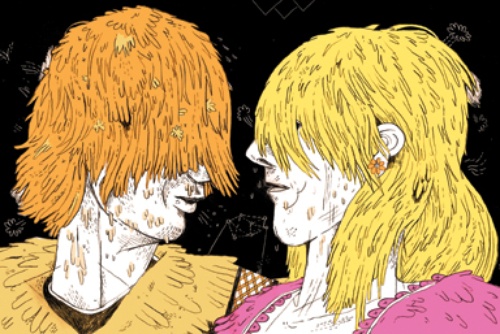
The Music We Hate: Sonic Youth
"Welcome to the post–Sonic Youth era: where getting in bed with corporate America is no longer frowned upon but practically mandatory."
Illustration by Josh J. Holinaty
As a noisy, self-consciously experimental band with an established following, Sonic Youth were already indie stars by the end of the eighties. Signing to DGC, a subsidiary of major label Geffen Records, in 1990—and successfully dodging the “sellout” tag—made them legends.
To the band, joining Geffen put them in the pantheon of proto-punk major-label heroes like the Stooges, the New York Dolls and the Ramones, all of whose eardrum-ravaging singles were aimed squarely at the charts. Twenty years later, not only has Sonic Youth’s bid for commercial success flopped—after eight fair-to-middling albums they’ve since left the label—they’ve actually managed to do something far worse: betray an entire generation of indie music.
In the eighties, rock bands chose to work with independent rather than major labels for two reasons: they distrusted the majors’ shady business practices, or their music was too weird to be commercial. For the most part, nobody in the indie world worried very much about Sonic Youth compromising their artistic integrity, since DGC seemed willing to let them make the squalling feedback-addled records they wanted to make—as straight-ahead as Goo and Dirty were, they showed little evidence of a label-mandated clean-up.
But what Sonic Youth’s DGC deal did do was make it acceptable for indie bands to work with big companies that were notorious for cheating artists out of their royalties and master recordings.
The theory was that Sonic Youth and Co. were infiltrating the mainstream from the inside. As Pitchfork’s Julianne Shepherd wrote in 2005, “America’s farthest reaches were finally able to access Sonic Youth’s music—which, in those pre-internet dark-ages, certainly rescued thousands of alienated teens from alternate fates as vaguely dissatisfied suburbanites and/or small-town tragedies.” Yes, you read that right: thousands of kids saved from vague dissatisfaction! Meanwhile, Sonic Youth’s presence on DGC helped convince Nirvana to sign to the label, delivering a huge payday for everyone until Kurt Cobain killed himself. Among his reasons? Distress over the pressures and contradictions of fame, which, on an indie, he might have avoided—or at least grown into more gradually.
Welcome to the post–Sonic Youth era: where getting in bed with corporate America is no longer frowned upon but practically mandatory; where bands jockey to place songs in TV commercials or pay lip service to true experimentalists like the late Sun Ra while churning out the same old garage-pop (hello, Yo La Tengo; greetings, King Khan). And where neo-folkies like She & Him and U2-style pop-rockers like Arcade Fire win credibility not because they make music the majors wouldn’t touch, or because they eschew the major system for ethical reasons, but because they’ve signed to Merge, a company founded on independent ideals that now functions more or less like a smaller, privately-owned version of a major label.
Thanks to Sonic Youth’s decoupling of DIY ideals from DIY practice, “indie” now includes a lot of commercial bands, and often really pretentious ones. Sonic Youth managed to link vaguely arty rock with the heroes of twentieth-century avant-garde music. And because of this, college kids who listen to the latest underground chanteuse think they’re better than the great unwashed Jack Johnson-loving masses—though they can’t quite tell you why being indie matters, or what it has to do with art. Hell, I’ve become a little fuzzy on it myself.
Related on maisonneuve.org:
—The Music We Hate
—The Music We Hate: Online Supplement
—Born Here
Subscribe — Follow Maisy on Twitter — Like Maisy on Facebook





